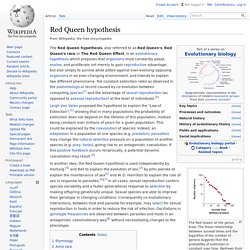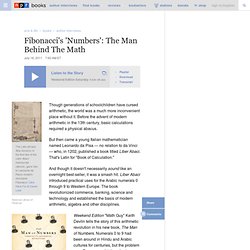

Steve Cartledge
Autodidacticism
Mind and Brain. Fractals. Douglas Adams. Noam Chomsky. Steve Jobs tribute from mlfilms.com Memory & Imagination. Red Queen's Hypothesis. The Red Queen hypothesis, also referred to as Red Queen's, Red Queen's race or The Red Queen Effect, is an evolutionary hypothesis which proposes that organisms must constantly adapt, evolve, and proliferate not merely to gain reproductive advantage, but also simply to survive while pitted against ever-evolving opposing organisms in an ever-changing environment, and intends to explain two different phenomena: the constant extinction rates as observed in the paleontological record caused by co-evolution between competing species[1] and the advantage of sexual reproduction (as opposed to asexual reproduction) at the level of individuals.[2]

Information Management. Science. A Universe from Nothing? Some of you may have been following a tiny brouhaha (“kerfuffle” is so overused, don’t you think?)

That has sprung up around the question of why the universe exists. You can’t say we think small around here. First Lawrence Krauss came out with a new book, A Universe From Nothing: Why There Is Something Rather Than Nothing (based in part on a popular YouTube lecture), which addresses this question from the point of view of a modern cosmologist. Then David Albert, speaking as a modern philosopher of science, came out with quite a negative review of the book in the New York Times. And discussion has gone back and forth since then: here’s Jerry Coyne (mostly siding with Albert), the Rutgers Philosophy of Cosmology blog (with interesting voices in the comments), a long interview with Krauss in the Atlantic, comments by Massimo Pigliucci, and another response by Krauss on the Scientific American site. I’ve been meaning to chime in, for personal as well as scientific reasons. Executive summary. Structure of influenza virus.
In this week’s discussion of swine flu A/Mexico/09 (H1N1), we have considered many aspects of influenza virus biology that might not be familiar to some readers of virology blog.

I thought it might be useful to explain how the virus multiplies, how it infects us, and how we combat infection. Today we’ll start with the basic structure of influenza virus, illustrated above. The influenza virion (as the infectious particle is called) is roughly spherical. It is an enveloped virus – that is, the outer layer is a lipid membrane which is taken from the host cell in which the virus multiplies. Inserted into the lipid membrane are ‘spikes’, which are proteins – actually glycoproteins, because they consist of protein linked to sugars – known as HA (hemagglutinin) and NA (neuraminidase).
Beneath the lipid membrane is a viral protein called M1, or matrix protein. This week, when we discussed the nucleotide sequence of swine influenza RNAs, we were referring to these RNA molecules. Understanding the Higgs Boson. This is a guest commentary.

See Mark Wise's bio below. Symphony of Science - A Wave of Reason. Fibonacci's 'Numbers': The Man Behind The Math. Your Days Are Numbered Try to imagine a day without numbers.

Never mind a day, try to imagine getting through the first hour without numbers: no alarm clock, no time, no date, no TV or radio, no stock market report or sports results in the newspapers, no bank account to check. It's not clear exactly where you are waking up either, for without numbers modern housing would not exist. The fact is, our lives are totally dependent on numbers. You may not have "a head for figures," but you certainly have a head full of figures. How did we — as a species and as a society — become so familiar with and totally reliant on these abstractions our ancestors invented just a few thousand years ago? For the most part, the story of numbers was easy to discover. Prior to the thirteenth century, however, the only Europeans who were aware of the system were, by and large, scholars, who used it solely to do mathematics. Excerpted from Man of Numbers: Fibonacci's Arithmetic Revolution by Keith Devlin. Quantum entanglement.
Quantum entanglement is a physical phenomenon that occurs when pairs or groups of particles are generated or interact in ways such that the quantum state of each particle cannot be described independently – instead, a quantum state may be given for the system as a whole.

Such phenomena were the subject of a 1935 paper by Albert Einstein, Boris Podolsky and Nathan Rosen,[1] describing what came to be known as the EPR paradox, and several papers by Erwin Schrödinger shortly thereafter.[2][3] Einstein and others considered such behavior to be impossible, as it violated the local realist view of causality (Einstein referred to it as "spooky action at a distance"),[4] and argued that the accepted formulation of quantum mechanics must therefore be incomplete.
History[edit] Wave function. However, complex numbers are not necessarily used in all treatments.

Louis de Broglie in his later years proposed a real-valued wave function connected to the complex wave function by a proportionality constant and developed the de Broglie–Bohm theory. The unit of measurement for ψ depends on the system. For one particle in three dimensions, its units are [length]−3/2. Complexity Theory. Game Theory.
Information theory. Life hacks. Life Long Learning. Help.